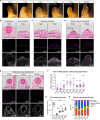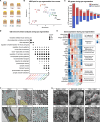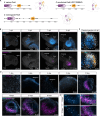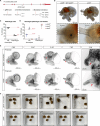A genetically tractable non-vertebrate system to study complete camera-type eye regeneration
- PMID: 40770180
- PMCID: PMC12328594
- DOI: 10.1038/s41467-025-61681-6
A genetically tractable non-vertebrate system to study complete camera-type eye regeneration
Abstract
Camera-type eyes are complex sensory organs susceptible to irreversible damage. Their repair is difficult to study due to the paucity of camera-type eye regeneration models. Identifying a genetically tractable organism with the ability to fully regenerate complete camera-type eyes would help overcome this difficulty. Here, we introduce the apple snail Pomacea canaliculata, capable of full regeneration of camera-type eyes even after complete resection. We defined anatomical components of P. canaliculata eyes and genes expressed during crucial steps of their regeneration. By exploiting the unique features of this organism, we successfully established stable mutant lines in apple snails. Our studies reveal that, akin to humans, pax6 is indispensable for eye development in apple snails, establishing this as a research organism to unravel the mechanisms of camera-type eye regeneration. This work expands our understanding of complex sensory organ regeneration and offers a way to explore this process.
© 2025. The Author(s).
Conflict of interest statement
Competing interests: The authors declare no competing interests.
Figures






Similar articles
-
The expression of Pax6 and retinal determination genes in the eyeless arachnid A. longisetosus reveals vestigial eye primordia.Evodevo. 2025 Jul 9;16(1):12. doi: 10.1186/s13227-025-00245-7. Evodevo. 2025. PMID: 40635118 Free PMC article.
-
Sterility induced by heat stress on the invasive apple snail Pomacea canaliculata is reversible but even short exposures cause long reproductive delays in females.J Therm Biol. 2025 Jul;131:104187. doi: 10.1016/j.jtherbio.2025.104187. Epub 2025 Jun 26. J Therm Biol. 2025. PMID: 40617060
-
Integrated Analysis of Survival, Physiological-Biochemical, and Transcriptomic Changes Reveals the Impact of Saline Stress on the Freshwater Snail Pomacea canaliculata.Ecol Evol. 2025 Jul 3;15(7):e71581. doi: 10.1002/ece3.71581. eCollection 2025 Jul. Ecol Evol. 2025. PMID: 40625329 Free PMC article.
-
Punctal occlusion for dry eye syndrome.Cochrane Database Syst Rev. 2017 Jun 26;6(6):CD006775. doi: 10.1002/14651858.CD006775.pub3. Cochrane Database Syst Rev. 2017. PMID: 28649802 Free PMC article.
-
Factors that influence parents' and informal caregivers' views and practices regarding routine childhood vaccination: a qualitative evidence synthesis.Cochrane Database Syst Rev. 2021 Oct 27;10(10):CD013265. doi: 10.1002/14651858.CD013265.pub2. Cochrane Database Syst Rev. 2021. PMID: 34706066 Free PMC article.
References
-
- Sánchez Alvarado, A. & Tsonis, P. A. Bridging the regeneration gap: genetic insights from diverse animal models. Nat. Rev. Genet.7, 873–884 (2006). - PubMed
-
- Srivastava, M. Beyond Casual Resemblance: Rigorous Frameworks for Comparing Regeneration Across Species. Annu. Rev. Cell Dev. Biol.37, 415–440 (2021). - PubMed
-
- Fernald, R. D. Casting a Genetic Light on the Evolution of Eyes. 313, 1914-1918 (2006). - PubMed
-
- Land, M. F. & Nilsson, D.-E. Animal eyes (Oxford University Press, 2012).
MeSH terms
Substances
LinkOut - more resources
Full Text Sources
Medical
Research Materials

